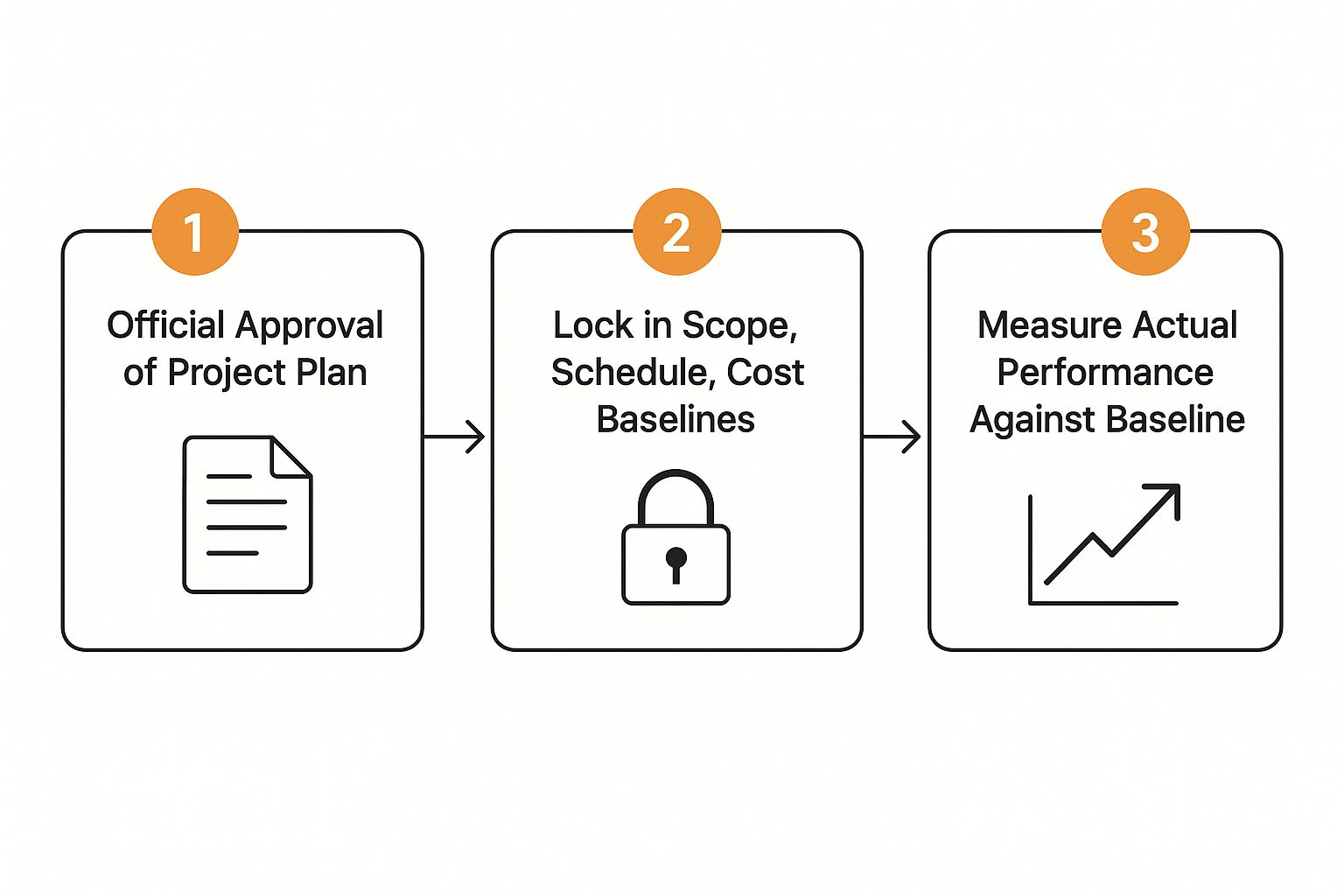To baseline a project is to create an approved, fixed plan for its scope, schedule, and cost. Think of it as the single source of truth for your project's performance—the agreed-upon starting point against which you'll measure all future progress, timelines, and spending.
What It Really Means to Baseline a Project
Ever tried starting a road trip without setting a destination in your GPS? You could drive for hours, but you'd have no real idea if you were on track, falling behind, or even heading in the right direction. That's a project without a baseline.
To baseline a project is to lock in that starting point and the planned route. It’s not just some preliminary draft; it's the official version of the plan that has been formally signed off on by all the key stakeholders.
This baseline is built on what project managers call the "triple constraint." To give you a clearer picture, let's break down these core components in a quick summary table.
The Three Pillars of a Project Baseline
This table summarizes the three essential parts of any solid project baseline and explains why each one is so critical for keeping things on the rails.
| Baseline Component | What It Defines | Why It Matters |
|---|---|---|
| Scope Baseline | The complete and detailed list of what the project will deliver—and just as importantly, what it won't. This includes the Work Breakdown Structure (WBS). | Prevents "scope creep" and ensures everyone has the same understanding of the final deliverables. |
| Schedule Baseline | The official project timeline, outlining the approved start and end dates for every task, phase, and milestone. | Acts as the official calendar for the project, making it easy to track if you're ahead, on time, or behind schedule. |
| Cost Baseline | The time-phased budget that shows approved project expenses spread out over its entire lifecycle. | Provides a clear financial roadmap, allowing you to monitor spending and manage the budget effectively from start to finish. |
Together, these three components create what's known as the performance measurement baseline. At its core, setting up a project baseline is all about measuring performance and controlling the outcome. This approved plan acts as a fixed reference point, allowing you to compare your actual progress against what you originally planned and spot any deviations early on. For a closer look at the numbers behind this, you can find more insights on project management statistics that highlight its importance.
The simple process flow below really drives home how a plan evolves into a baseline that's actively used for measurement.
As the graphic shows, a baseline isn't just a document that gets filed away. It's a formally locked-in reference point that makes performance tracking possible. It's the essential bridge between your initial planning and actually controlling the project as it moves forward.
Building Your Scope Baseline to Prevent Creep
Think of your scope baseline as the official contract for your project. It’s the document that spells out exactly what your team will deliver—and just as importantly, what you won't. This isn't just a list of tasks; it's a shared agreement that becomes your best defense against the dreaded "scope creep."
The heart of a strong scope baseline is the Work Breakdown Structure (WBS). This is simply a practical way to deconstruct big, intimidating goals into smaller, more manageable pieces. You're essentially creating a detailed map of the project's entire terrain before anyone takes a single step.
From Vague Goals to Concrete Deliverables
Let's say your project is to "launch a new marketing website." That’s far too broad to act as a baseline. The WBS forces you to get specific and break it down into tangible parts.
- Top-Level Deliverable: New Marketing Website
- Major Components: Homepage Design, About Us Page, Services Section, Contact Form, Blog Functionality
- Work Packages (under Homepage): Wireframing, UI/UX design mockups, copy development, front-end coding, back-end integration
Each of those "work packages" is now a measurable unit. This level of detail is absolutely critical for estimating time and costs accurately down the road. It also means that when a stakeholder inevitably asks for "just one more feature," you can point to the agreed-upon WBS and start a formal change request process.
A well-defined scope baseline doesn't just list tasks; it establishes clear boundaries. It’s the difference between saying "we'll build a house" and having a full architectural blueprint that everyone has signed off on.
Of course, a robust scope baseline also depends on solid requirements. For tips on getting that right, check out this guide on writing clear business requirements to ensure everyone is on the same page from day one.
Ultimately, a detailed WBS feeds directly into smarter project management. With clearly defined work packages, you can assign resources and track progress with much more precision, a core part of effective resource planning. By creating this clear and agreed-upon scope, you baseline the project against a fixed set of deliverables, making any deviation immediately obvious.
Crafting a Realistic Schedule Baseline
Once your scope is locked in, the next big question always comes up: "So, when will it be done?" Building a realistic schedule baseline is how you answer that question with confidence. This isn't just about picking a date out of thin air; it's about turning your defined work packages into a logical, time-bound sequence of events.
The whole process starts with sequencing your activities. You need to figure out which tasks depend on others before they can kick off. Think about planning a corporate event—you can't possibly start "ticket sales" until after "venue booking" and "speaker confirmation" are sorted. Mapping out these dependencies is what gives your project its natural flow.
Estimating Durations and Finding the Critical Path
With all your tasks in order, the next job is estimating how long each one will take. This is where a bit of experience—and some proven techniques—really comes in handy. It’s tempting to be overly optimistic, but trust me, a single delay can create a massive ripple effect down the line.
When you combine the sequence of your tasks with how long they'll take, you can pinpoint the critical path. This is the longest chain of dependent tasks that ultimately decides the shortest possible time your project can be completed in.
Any delay on the critical path will directly push back the entire project's finish date. It’s the spine of your schedule, and it demands your closest attention.
This skill is more vital now than ever. As projects get more complex, the demand for project managers who can effectively baseline a project is climbing. In fact, most project managers (59%) are juggling 2-5 projects at once, making a rock-solid schedule baseline absolutely essential for managing overlapping workloads. You can find more details on this trend in these project management statistics.
Building a Resilient Schedule
A schedule baseline on paper is one thing, but one that can actually survive contact with reality is another. To build a plan that's truly resilient, you'll need to take a few key actions:
- Confirm Resource Availability: Don't just assume your go-to developer or designer is free. You have to verify their availability and actually book their time to prevent frustrating bottlenecks later on.
- Incorporate Buffers: Any seasoned manager knows that things go wrong. Build some contingency time (or buffers) around high-risk tasks or tricky phases. This helps absorb minor delays without derailing the entire schedule.
- Review and Refine: Get the draft schedule in front of your team and key stakeholders. Their feedback is invaluable—they'll often spot dependencies or estimate task durations more accurately than you could alone.
Creating a detailed schedule is a fundamental skill for any project manager. To see how these concepts fit into the bigger picture, check out our ultimate guide to project management with time tracking.
Hammering Out an Accurate Cost Baseline
Alright, with your scope locked in and your schedule mapped out, it’s time to talk about the money. Building a cost baseline isn't just about coming up with a single number. It's about translating all that planned work into a detailed, time-phased budget—a financial roadmap showing what you plan to spend and when you plan to spend it.
The bedrock of any solid cost baseline is your Work Breakdown Structure (WBS). Every single cost, from labor hours and materials to software licenses and travel, has to be tied directly back to a specific work package in your scope. This makes your budget transparent and defensible because every dollar has a clear purpose.
From Estimates to a Time-Phased Budget
Think about our corporate event example again. You wouldn't just throw all the expenses into one big bucket labeled "event cost." That's a recipe for disaster. Instead, you'd break it down and calculate costs for each WBS item over the project timeline.
It might look something like this:
- Month 1: Venue deposit ($10,000), Speaker booking fees ($15,000)
- Month 2: Catering down payment ($8,000), Marketing material design ($3,000)
- Month 3: Final payments for all vendors, on-site staff wages
When you add up these costs across your timeline, you get your cost baseline. This phased approach is way more practical than a simple total estimate. It lets you manage cash flow effectively and gives you a clear picture of your spending against the plan at any point in the project.
A project budget is the total estimated cost. The cost baseline is the approved, time-phased plan for spending that budget. Think of it as the financial yardstick you'll use to measure performance week after week.
Planning for the Unexpected
Let's be real—no project goes exactly as planned. Surprises happen. That's why a smart cost baseline always includes reserves. These aren't just slush funds; they're carefully calculated buffers to handle uncertainty.
There are two main types of reserves you need to know about:
- Contingency Reserves: This is money set aside for the "known unknowns." These are the risks you've already identified in your risk register, like the chance a key vendor might hike their rates or a piece of equipment could need repairs. This reserve is part of your cost baseline.
- Management Reserves: This is an extra buffer for the "unknown unknowns"—the completely unforeseen problems that pop up out of nowhere, like a sudden supply chain disruption or a major shift in the market. This reserve is usually held by senior management and sits outside the official project baseline.
By meticulously estimating costs, phasing them over your project's timeline, and building in contingency reserves for known risks, you create a financial benchmark that’s both accurate and realistic. This is the only way to properly baseline a project and keep its financial health firmly under your control.
Managing and Protecting Your Baselines
Getting your scope, schedule, and cost baselines locked in feels like a huge win, but let's be real—the work has just begun. A baseline is only as good as your ability to protect it. Without a formal approval process and a clear system for handling changes, that carefully crafted plan can fall apart before you know it.
The first move is getting formal sign-off from your stakeholders. This isn't just a box-ticking exercise; it's the moment your plan officially becomes the performance measurement baseline. When they sign off, they're agreeing that this is the yardstick we'll all use to measure success.
Establishing a Change Control Process
Look, change is going to happen. The goal isn't to stop it, but to manage it. A solid change control process is your best defense against scope creep, ensuring every single adjustment is properly evaluated for its impact on the project's scope, timeline, and budget before it gets the green light.
This is how you shut down those casual "can you just add this one thing?" requests that can slowly derail everything.
Your process doesn't need to be complicated, just firm. It should follow a few clear steps:
- Someone submits a formal change request.
- The project manager digs in and analyzes the request’s impact on the triple constraint.
- A change control board (or just the key stakeholders) reviews that analysis.
- A decision is made: approve, reject, or put it on the back burner.
When you baseline a project, you're creating a stable foundation. A change control process acts as the gatekeeper, ensuring that any modifications to that foundation are deliberate, documented, and fully understood by everyone involved.
Essential Baseline Management Tools
Managing this all on a spreadsheet is a recipe for disaster. Modern tools are pretty much non-negotiable for keeping baselines intact. In fact, over 82% of companies now rely on project management software to keep things running smoothly. With the market for these tools expected to hit $12.02 billion by 2030, it’s clear they’re central to effective project delivery.
Here’s a quick look at some of the key players and what they offer for baselining:
| Tool | Key Baselining Feature | Best For |
|---|---|---|
| Microsoft Project | Allows setting and managing multiple baselines (up to 11) for detailed variance analysis. | Complex, large-scale projects requiring deep control and reporting. |
| Primavera P6 | Robust baseline management with unlimited baseline versions and advanced what-if scenario planning. | Enterprise-level construction, engineering, and industrial projects. |
| Jira | Primarily for agile, but baselines can be managed using version releases and roadmap snapshots. | Software development and agile teams who value flexibility over rigid baselines. |
| Asana | Users can duplicate a project at key stages to create a "baseline" version for later comparison. | Teams needing a simple, visual way to track progress against an initial plan without formal PM overhead. |
Choosing the right tool depends entirely on your project's complexity and your team's workflow, but having a dedicated system is what truly matters.
Finally, effective management means you’re constantly measuring your actual performance against the plan you set. This is where a clear system for project progress tracking becomes your best friend, helping you spot deviations early so you can get things back on track. It's this disciplined approach that ensures your project stays aligned with its goals, no matter what surprises pop up along the way.
Your Project Baselining Questions Answered
Even with a perfect process laid out, the real world has a way of throwing curveballs. When you actually start baselining a project, practical questions always pop up. Let's dig into some of the most common ones project managers run into and get you some straightforward answers.
Can a Project Baseline Be Changed?
Yes, but it shouldn't be a casual affair. Any changes need to go through a formal change control process. A baseline isn't meant to be set in concrete, totally unchangeable. When a major, approved change hits your scope, schedule, or budget, you'll likely need to "re-baseline."
This essentially creates a new official yardstick for measuring all future performance. The key is to use this tool sparingly. If you re-baseline every time there's a hiccup, you lose that original comparison point, making it nearly impossible to see how the project truly performed over its entire lifecycle.
What Is the Difference Between a Project Plan and a Baseline?
It's easy to get these two mixed up. Think of the project plan as the entire, detailed instruction manual for your project. It’s a living, breathing document that guides the day-to-day work, holding everything from your communication strategy to your risk register.
The project baseline, on the other hand, is a specific, approved snapshot of the most critical elements of that plan: scope, schedule, and cost. To put it another way, the plan is the whole map; the baseline is the officially agreed-upon route you'll be measured against.
The baseline is a component of the overall project plan, not a separate entity. It’s the formally signed-off part of the plan that gets locked for performance measurement.
How Often Should I Measure Performance Against the Baseline?
The right cadence really depends on your project's pace and complexity. For most projects I've run, a weekly or bi-weekly check-in hits the sweet spot.
This rhythm is frequent enough to catch deviations early without becoming an administrative burden. The whole point is to spot variances before they get out of hand. Trust me, it's far easier to correct a small slip-up in week three than it is to fix a massive budget overrun in month three. You're trying to stop small issues from snowballing into project-killers.
What Happens If We Are Already Off Baseline?
First off, don't panic. This happens on almost every project at some point. The very next thing you need to do is a variance analysis to figure out why you’re off track.
- Was it a one-time problem, like a supplier delivering materials a week late?
- Or are you dealing with a systemic issue, like consistently underestimating how long certain tasks will take?
Once you know the root cause, you can put corrective actions in place to steer the project back on course. If the deviation is just too big to recover from, that's when you'll need to submit a formal change request to get stakeholder approval and officially re-baseline the project.
Stop chasing timesheets and start getting real-time insights into your projects. TimeTackle automatically captures work activities from your team's calendar, giving you the data you need to baseline, track, and manage projects with precision. See how it works at https://www.timetackle.com.







